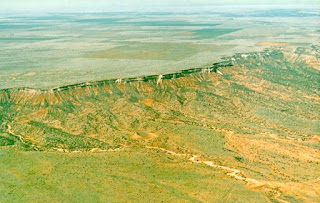Places: the Staked Plains
This terminology appears often in western movies, novels and popular histories dealing with Plains tribes and their frequent conflicts with Whites. Staked plain is a literal translation of the Spanish term, llano estacado. The staked plain covers eastern New Mexico and Northeastern Texas, 33 counties in Texas and 4 in New Mexico. A huge escarpment raises this area of the Great Plains up to 3,000 to 5,000 feet in a giant mesa formation. Estacado in Spanish refers to a palisade, such as one would see around a fort. The escarpment around this portion of the Great Plains gave the early Spanish explorers the idea of a palisade, hence the name.
The stake plains have long hot summers and freezing cold winters. The land is dry due to low rainfall and difficult to farm. For soldiers sent here in the 19th century to track down Comanche, Kiowa, Apache and other tribes, a tour of duty could be a death sentence. Hunger, thirst, and disease from dusty, unsanitary conditions claimed almost as many lives as Native arrows and bullets. Because of its flat terrain, the staked plains were ideal for horses and tribes with a horse culture reigned supreme. Francisco Coronado was the first European to record being on the staked plains in 1541, calling them a sea of grass. The Comanche moved into the area in the 17th century, displacing the Lipan Apaches. The staked plains were part of Comancheria, acknowledged Comanche territory by Whites and Natives alike. A Comanche trail extended from the staked plains, across the Rio Grande and into Chihuahua. After the Civil War, the 9th and 10th Cavalry, the Buffalo soldiers, spent much time warring against the Comanche on these vast grasslands. The plains are home to cities such as Amarillo, Midland, Lubbock, and Odessa, Texas.
The stake plains have long hot summers and freezing cold winters. The land is dry due to low rainfall and difficult to farm. For soldiers sent here in the 19th century to track down Comanche, Kiowa, Apache and other tribes, a tour of duty could be a death sentence. Hunger, thirst, and disease from dusty, unsanitary conditions claimed almost as many lives as Native arrows and bullets. Because of its flat terrain, the staked plains were ideal for horses and tribes with a horse culture reigned supreme. Francisco Coronado was the first European to record being on the staked plains in 1541, calling them a sea of grass. The Comanche moved into the area in the 17th century, displacing the Lipan Apaches. The staked plains were part of Comancheria, acknowledged Comanche territory by Whites and Natives alike. A Comanche trail extended from the staked plains, across the Rio Grande and into Chihuahua. After the Civil War, the 9th and 10th Cavalry, the Buffalo soldiers, spent much time warring against the Comanche on these vast grasslands. The plains are home to cities such as Amarillo, Midland, Lubbock, and Odessa, Texas.




Comments
Post a Comment